81+ Horrific Healthcare Fraud Statistics
Here are over 81 healthcare fraud statistics to give you an idea of what it is, who commits the fraud, and the consequences of the crime.

Medicare processes more than 4.5 million claims each day. As you can imagine, it’s often difficult to sort through all of those claims to figure out which ones are real versus fraudulent.
That last statement likely doesn’t surprise you. You’re probably well aware of how complicated the financial side of healthcare can be. Of course, the “financial side” of healthcare is called the revenue cycle.
The revenue cycle starts the moment a patient calls the practice to seek treatment. It ends with the full collection of any amount of money owed. This means that both the patient and the insurance companies reimburse your practice for the services you perform. Although that sounds simple, the healthcare revenue cycle has many roadblocks and nuances, making it fickle and quite the headache.
The problem is that getting paid is easier said than done. There are billing hiccups, denials, patients not paying, and insurance coverage expiring. Needless to say, there are many reasons why your bottom line isn’t where you would want it to be.
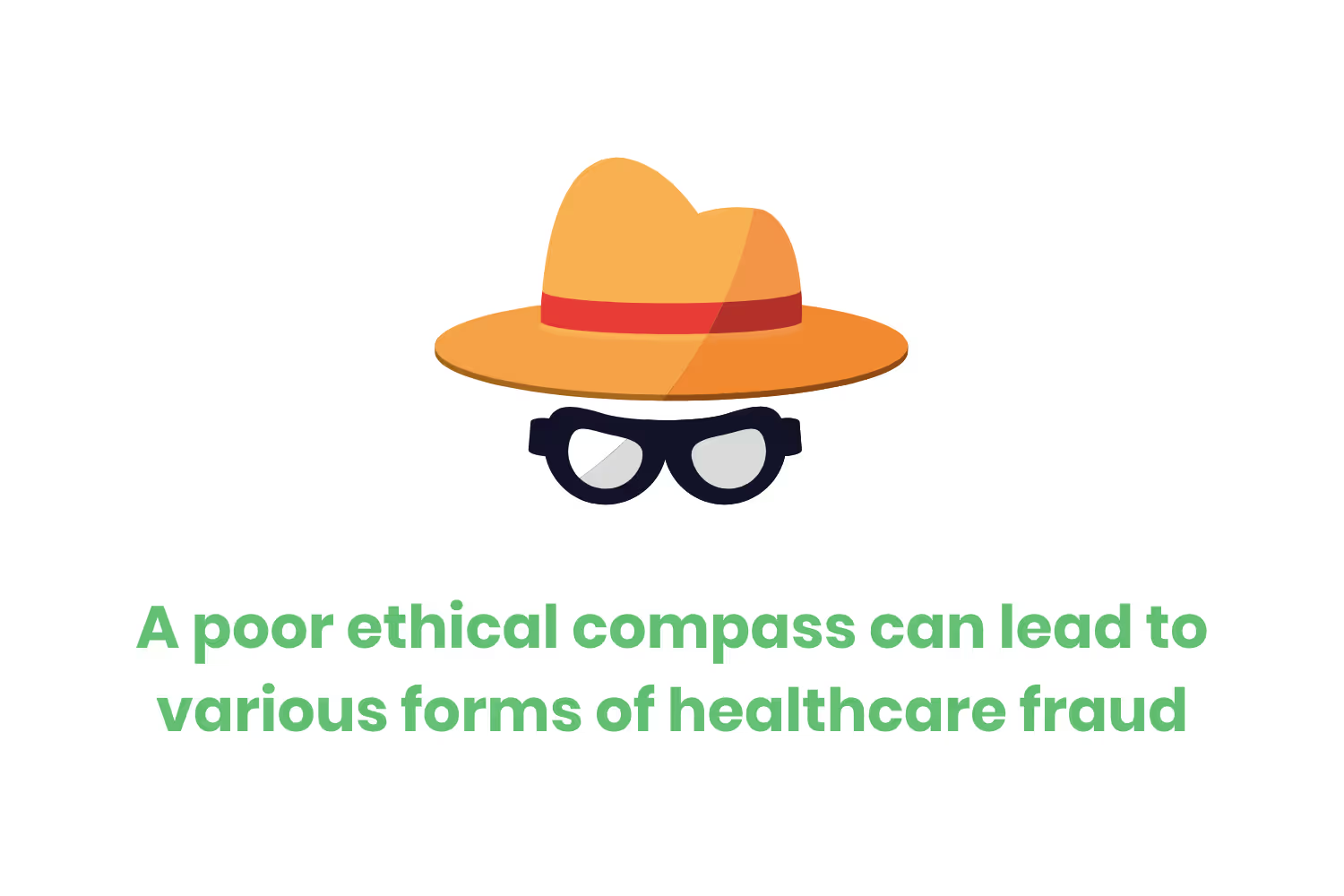
When it comes to financial problems, some people’s sense of ethics and morals will degrade to fix the lining in their pockets. This can lead to various forms of healthcare fraud. These scams are often connected to prescriptions and pills or getting deeper into the wallets of insurance providers.
No matter where you work in the world of healthcare, it’s important you educate yourself on the healthcare fraud situation. Here are over 81 healthcare fraud statistics to give you an idea of what it is, who commits the fraud, and the consequences of the crime.
Types of Healthcare Fraud
There are many different types of healthcare fraud. Some fraud happens because of the poor morals and ethics of medical providers. Another fraud happens involving prescriptions or people trying to profit off of someone else’s insurance.
At the end of the day, some people don’t have a moral compass. Those individuals bend the rules for their gain. Over time, healthcare fraudsters get more creative and their techniques become more extreme.
Below are a variety of examples of how healthcare fraud occurs.
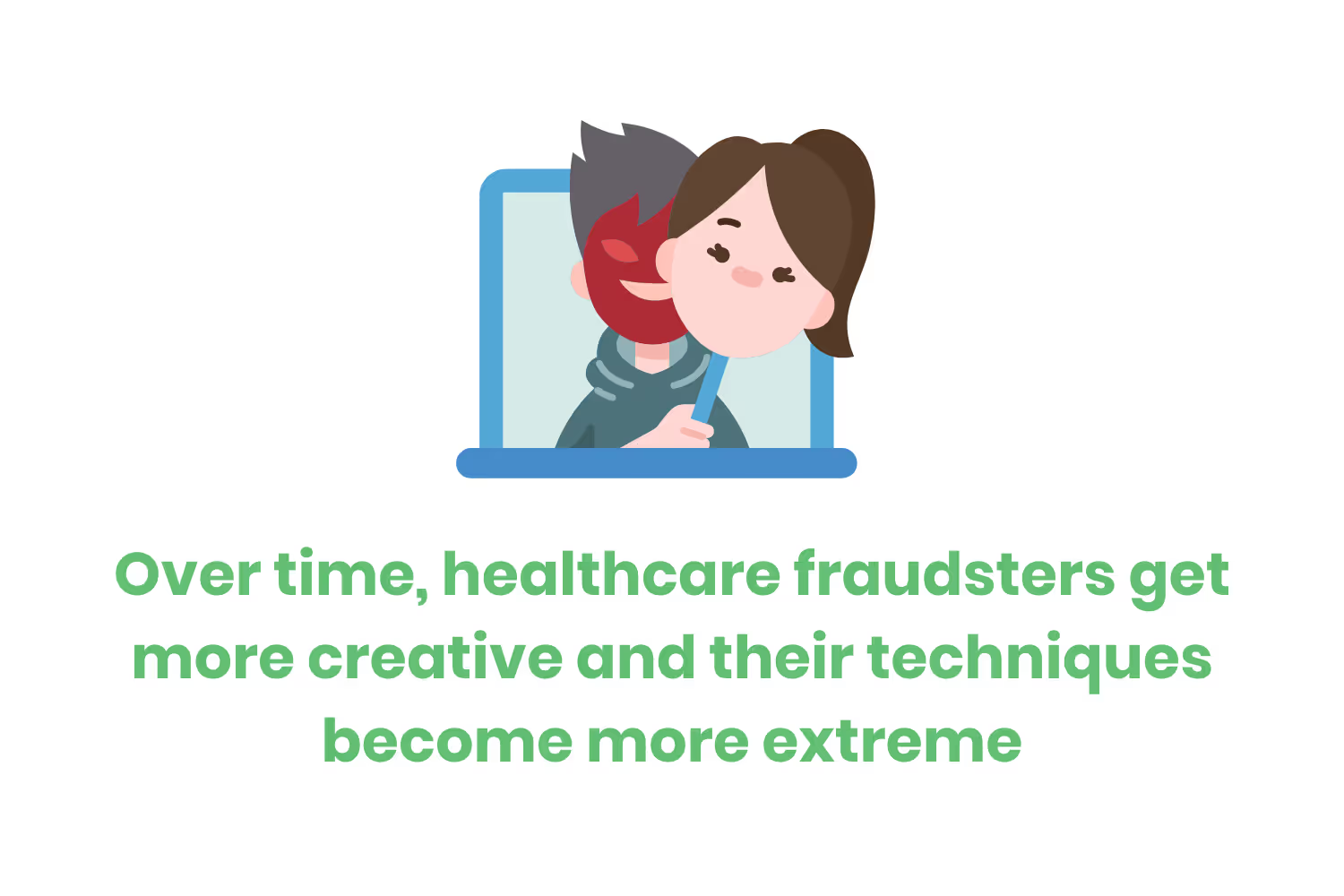
Medical Provider Fraud
Double billing happens when a provider submits the same claims for the same service more than once. (FBI) From a fraud perspective, it happens to trick the insurance companies to pay the healthcare provider more than the allotted amount. It’s a method to artificially inflate the number of patients a doctor sees and the practice’s bottom line.
Similarly, there’s another term called unbundling. Unbundling happens when a healthcare entity submits multiple bills for the same service. Although this sounds similar to double billing, there’s a difference. (FBI) Unbundling involves billing for each step of a procedure as if they are separate procedures. (NHCAA) This is also a method to artificially inflate a practice’s revenue and profit margins.
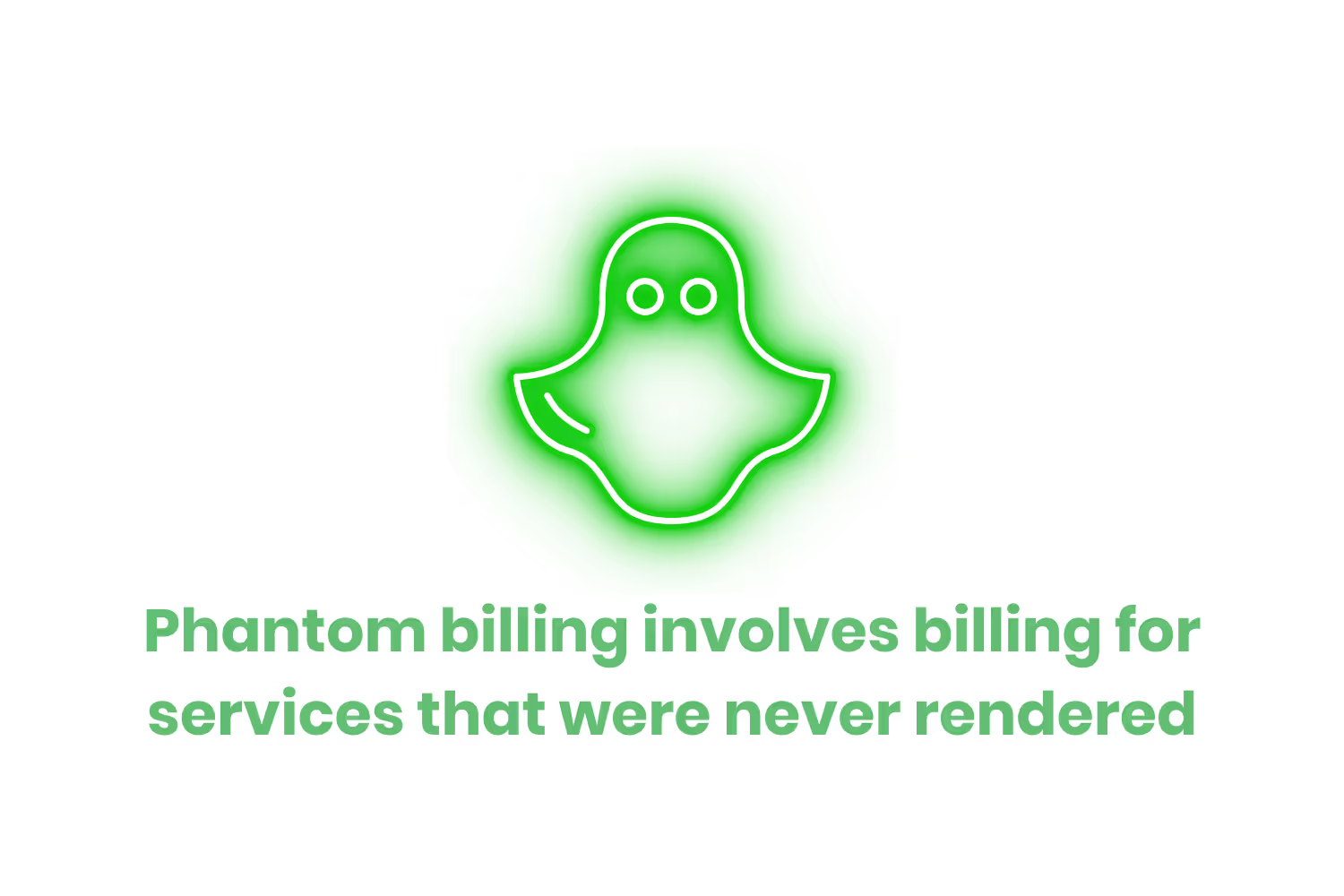
Phantom billing is a form of medical provider fraud that involves billing for services that were never rendered. (FBI) This involves the use of genuine patient information, sometimes through employing identity theft, to fabricate claims. Phantom billing can also happen when legitimate claims have charges for procedures or services that never took place. (NHCAA)
A telltale sign of phantom billing is that there’s a lack of supporting documentation for the fake claims. For example, if there’s a lack of documentation such as height and/or weight, there’s a good chance the claims are fake. (Fraud Magazine)
Billing for a non-covered service through false pretenses as a covered service is another form of medical provider fraud. (Fraud Magazine)
This type occurs when a doctor tries to obtain insurance payments by disguising the treatment they provide as a different, medically necessary covered treatment. This type of fraud is often seen in the world of cosmetic surgery schemes. (NHCAA)
However, this phenomenon also occurs in other realms of medicine, especially when it comes to experimental treatments. Sometimes doctors will treat someone with an experimental medicine, but bill the insurance companies with a different code that’s accepted. (Fraud Magazine)
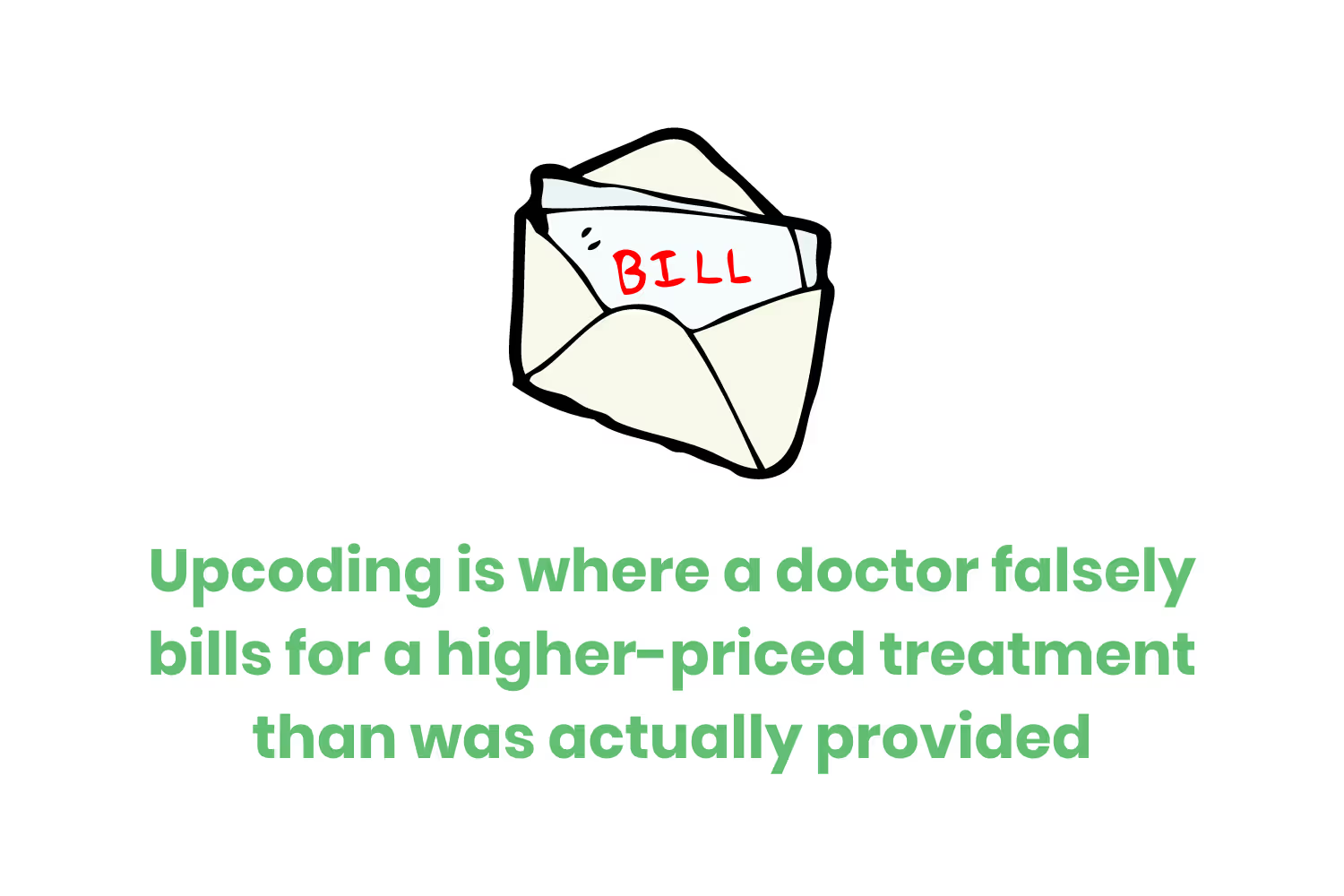
Upcoding is a type of billing fraud where a healthcare entity falsely bills for a higher-priced treatment than was actually provided. (FBI)
This often requires the accompanying “inflation” of the patient’s diagnosis code. The doctor will falsely diagnose the patient in bills for a more serious condition consistent with the false procedure. (NHCAA)
For example, a doctor could intentionally misdiagnose an elderly patient who fell inside a nursing home with “head trauma” needing a CT scan and blood tests. The crooked provider didn’t necessarily draw blood or conduct the scan, but they falsely report it on paper.
One of the telltale signs of this type of fraud is that an in-patient will mysteriously get better as soon as insurance coverage runs out. (Fraud Magazine)
Similarly, some fraudsters perform medically unnecessary services. The sole purpose of this is to generate insurance payments to fraudulently increase the provider’s bottom line. Common examples of this fraud scheme include nerve conditions and genetic testing. (NHCAA)
Another similar fraud scheme is when a doctor falsifies a patient’s diagnosis and medical records. They do this to justify tests, surgeries, and other procedures that aren’t medically necessary. (NHCAA) Unlike upcoding, doctors who engage in this type of fraud will actually conduct unnecessary procedures.
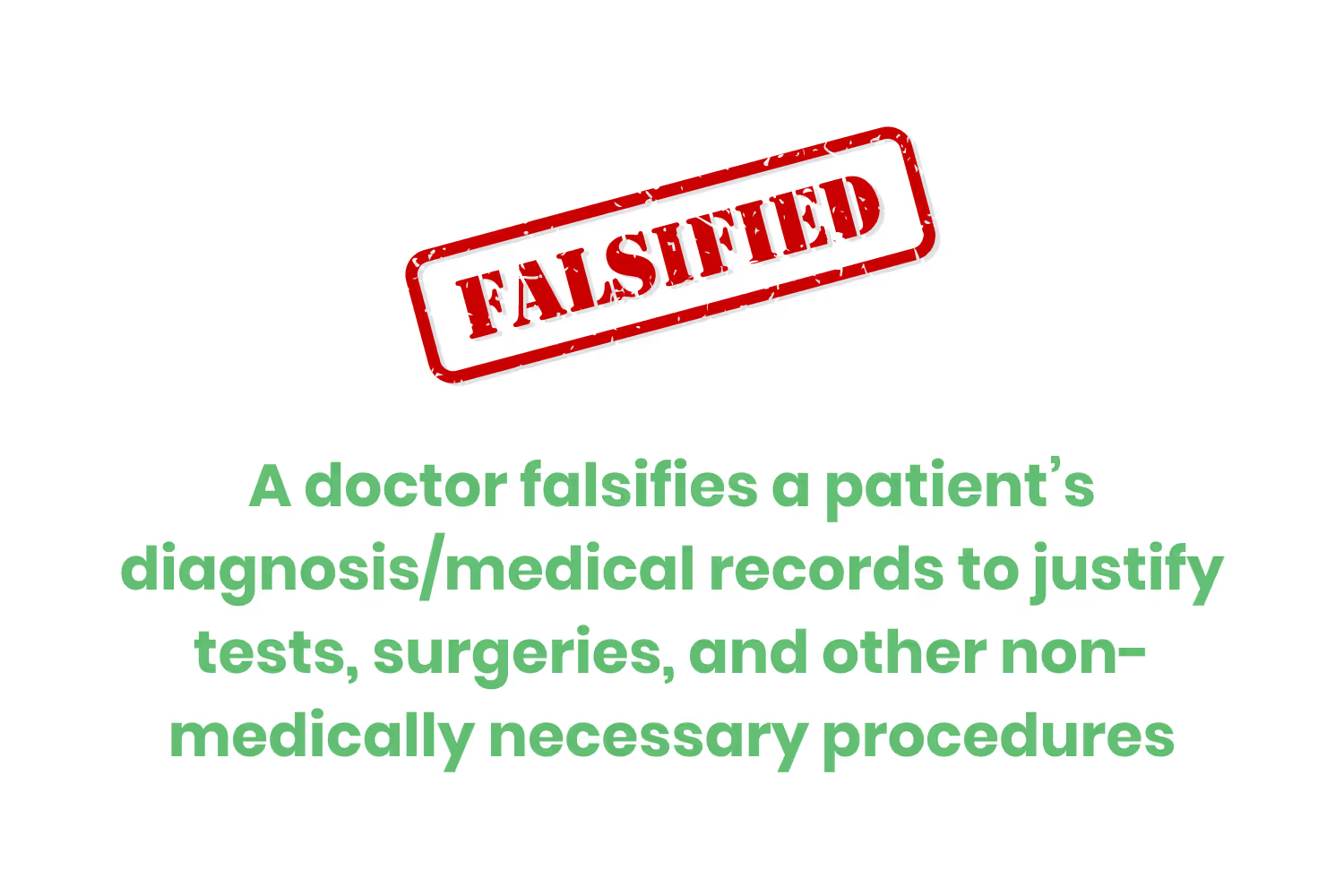
Deductible and copayments are areas prone to medical fraud. Sometimes, a doctor will bill a patient for more than the required copay amount. When this happens, the services are often prepaid or paid in full by the benefit plan under the terms of a managed care contract. (NHCAA)
Increasing deductibles is not as common as decreasing deductibles. Waiving patient copays or deductibles and overbilling the insurance carrier or benefit plan is one such form of fraud. (NHCAA)
Healthcare entities may pity their patients and their inability to see their doctors due to some of the expenses. Regardless, some providers waive deductibles or copayments and then submit other false claims to insurance companies to balance out their bottom line. (Fraud Magazine)
Patient Fraud
Bogus marketing is a type of healthcare fraud where someone convinces patients to provide information for the fraudster’s benefit (FBI).
For example, someone could offer you money to use your Medicare number to bill for prescription drugs. They could offer you other types of compensation, like some of your new pills, to pick up prescriptions on your behalf. (SMP)

Someone commits some form of bogus marketing when they obtain the personal information of a patient to…
- Bill for non-rendered services
- Steal their identity
- Enroll the patient in a fake benefit plan
Identity theft, also known as identity swapping, is when the wrong person uses someone’s health insurance information. Sometimes, the patient knows someone else is using their health insurance or allows another person to use their insurance. (FBI)
Another type of patient fraud occurs in the form of impersonating healthcare professionals. This happens when someone provides or bills for healthcare services or equipment when they don’t have a medical license. (FBI)
Prescription Fraud
Since the 1980s, prescription drug abuse leads thousands of people to an early grave.
According to the Centers for Disease Control and Prevention (CDC), about 15,000 people die each year from prescription medicine overdoses. These overdoses lead to an additional 1.2 million emergency room visits every year. (BCBS)
The abuse of controlled substances is a serious health concern today and will continue to be in the next ten years. Pharmacies need to maintain constant vigilance against prescription fraud. (DOJ - DEA)

Forgery is one of the most common types of prescription fraud. Forgery is where someone (often a patient) creates or uses forged prescriptions. (FBI)
You see, people steal legitimate prescription pads from physicians' offices. The thief will use the stolen pad to write prescriptions for fictitious patients. (DOJ - DEA)
Another type of forgery isn’t so blatant. Some patients try to get more medicine by altering the legitimate prescription. They will try to add numbers to increase the number of pills and/or the number of refills. (DOJ - DEA)
The third main type of forgery involves the call-back number. Some drug abusers will steal legitimate prescription pads and alter the call-back number. The fake number leads to the abuser’s accomplice to fraudulently verify the fake prescription. Sometimes the drug abusers will call in their own prescriptions and give their own phone numbers as a call back confirmation. (DOJ - DEA)

Diversion is another common type of prescription fraud. Diversion fraud involves diverting legal prescriptions for illegal uses. When this happens, someone may sell their prescription medications to another person. The seller may not abuse the drugs themselves, but if they no longer need the medicine and could use the extra cash, they may sell the pills to someone to make a quick buck. (FBI)
Many people are familiar with the term “doctor shopping” because of police and detective television shows. Doctor shopping is where someone visits multiple providers to get prescriptions for a controlled substance. (FBI)
People may also doctor shop if they (or a family member) don’t receive the diagnosis they want. These people often try to profit from charity organizations since a “mysterious illness” alters the family’s dynamics.
General Healthcare Fraud Statistics
Treating people’s health conditions is expensive. In 2018, people spent $3.6 trillion on healthcare in the United States. This translates to billions of health insurance claims since most people need some sort of coverage to afford medical care. (NHCAA)
In other words, health insurance has a large impact on the revenue and profits of healthcare entities.
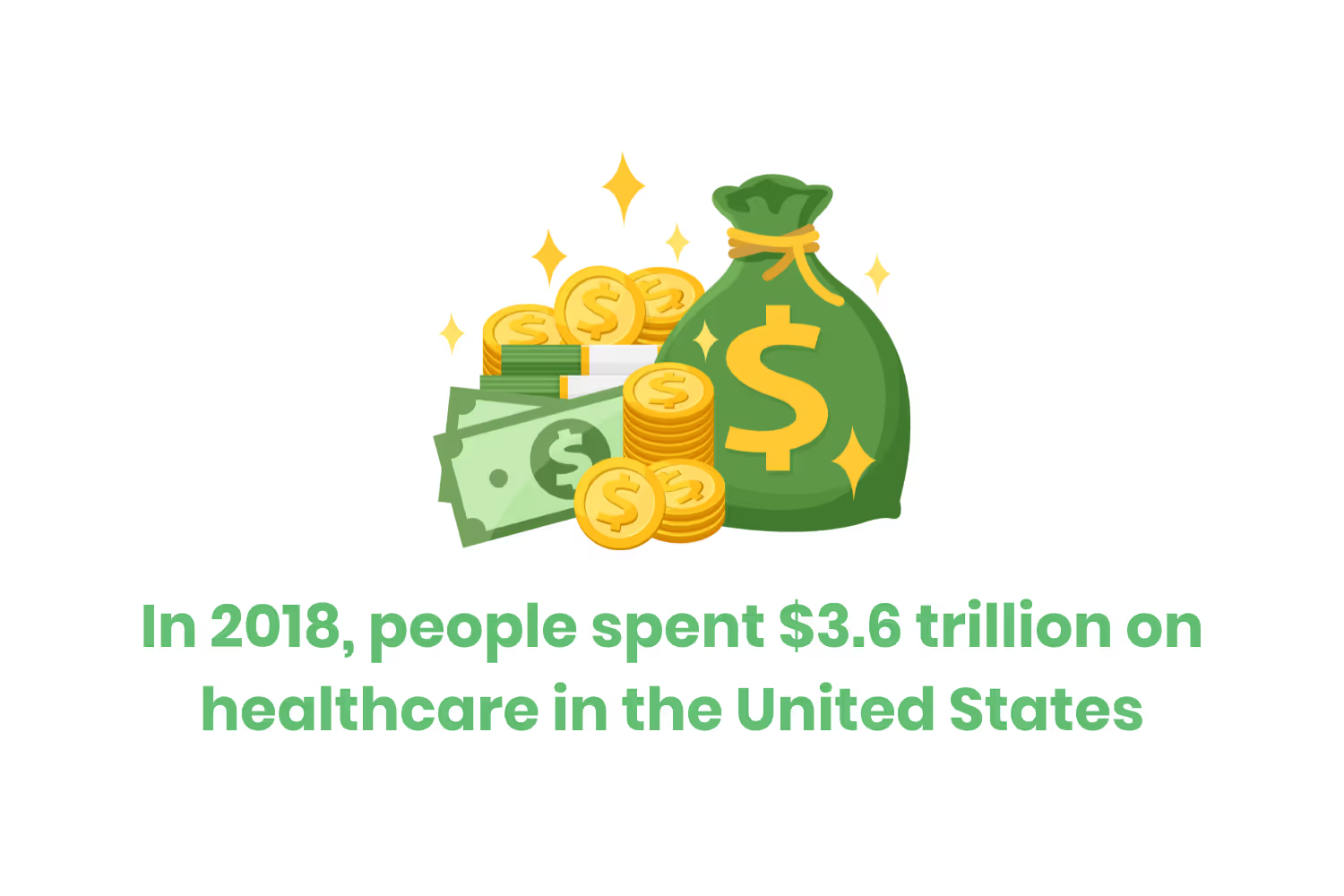
That said, there’s a slight problem with the healthcare revenue cycle. You see, 77% of healthcare providers say that collecting payment from patients takes more than 30 days. This lagging effect negatively affects the healthcare revenue cycle.
To dig the hole deeper, many patients don’t pay their bills. Even if you send their information to a collection agency, there’s no guarantee that you will receive payment for the services you provided.
Some healthcare providers try to fudge the lines to compensate for the volatile revenue cycle of the healthcare world. They’ll try to compensate for the patient side of payment by fraudulently increasing the money they receive from insurance agencies.

Now, I say “fraudulently” because healthcare fraud is a federal crime. Many federal agencies and organizations investigate and convict people of fraud. More on that later.
Below are some general healthcare fraud statistics that can help explain the situation in the United States over the last few years.
- In 2018 the DOJ experienced its largest healthcare fraud enforcement action in history. (NMLRA)
- In the fraud enforcement action, the federal government charged over 602 defendants with healthcare-related fruading schemes.
- Charged individuals include 165 doctors, nurses, and other medical professionals.
- The fraud schemes involved more than $2 billion.
- Due to healthcare fraud, there are more than 12 million opioid pills prescribed illegally a year. (DOJ Press Release)
- The U.S. The Sentencing Commission received 57,287 reports of healthcare fraud cases in 2021. (U.S. Sentencing Commission)
- 4,35 of these cases involved theft, property destruction, and fraud.
- Since 2017, healthcare fraud decreased by 28.7%. (U.S. Sentencing Commission)
- The 2021 Healthcare Fraud National Enforcement Action alleges this type of fraud correlates to $1.4 billion in losses. (DOJ Press Release)
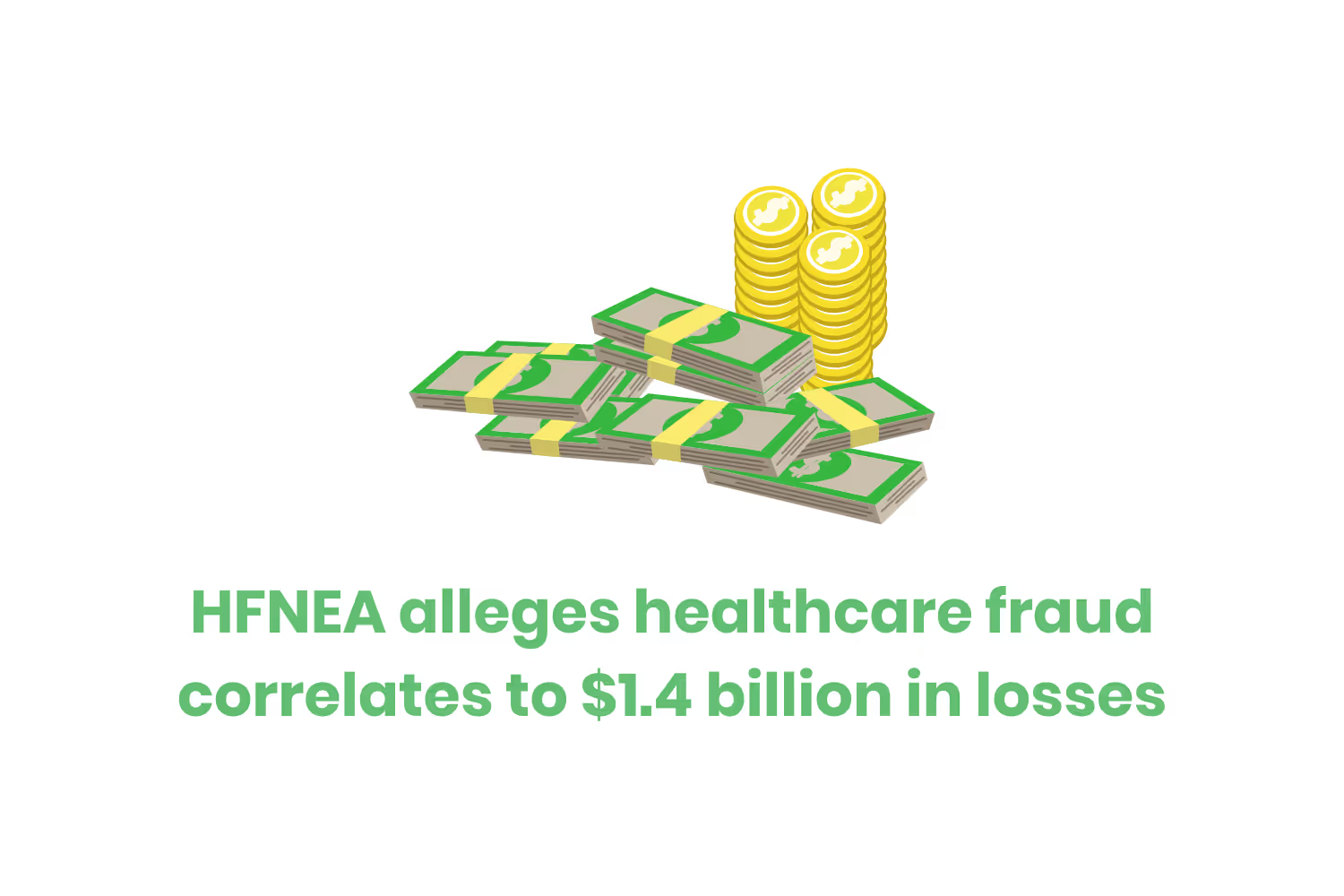
- The largest amount of alleged fraud loss relates to schemes involving telemedicine. (DOJ Press Release)
- It relates to…
- Over $1.1 billion in allegedly false and fraudulent claims.
- 43 criminal defendants.
- 11 judicial districts.
- It relates to…
- Healthcare fraud costs the nation about $68 billion annually. (BCBS - Michigan)
- Conservative estimates place healthcare fraud constituting 3% of total healthcare expenditures. (NHCAA)
- Some government and law enforcement agencies believe fraud loss is as high as 10% of healthcare expenditures
- Non-conservative estimates put the cost of healthcare fraud to be as high as $300 billion. (NHCAA)
- 8.0% of theft, property destruction, and fraud in the U.S. happen in the realm of healthcare fraud. (U.S. Sentencing Commission)
- Sober home cases correlate to false and fraudulent claims totaling over $133 million.
- Those schemes involve illegal kickbacks and bribery schemes to refer patients to substance abuse treatment facilities where patients had unnecessary tests and treatments. (DOJ Press Release)

Offender Characteristics
Anyone can commit healthcare fraud if they have a degraded moral compass. That means that it is hard to picture what a healthcare fraudster can look like. Although this is true, healthcare fraud data can provide some averages and likelihoods.
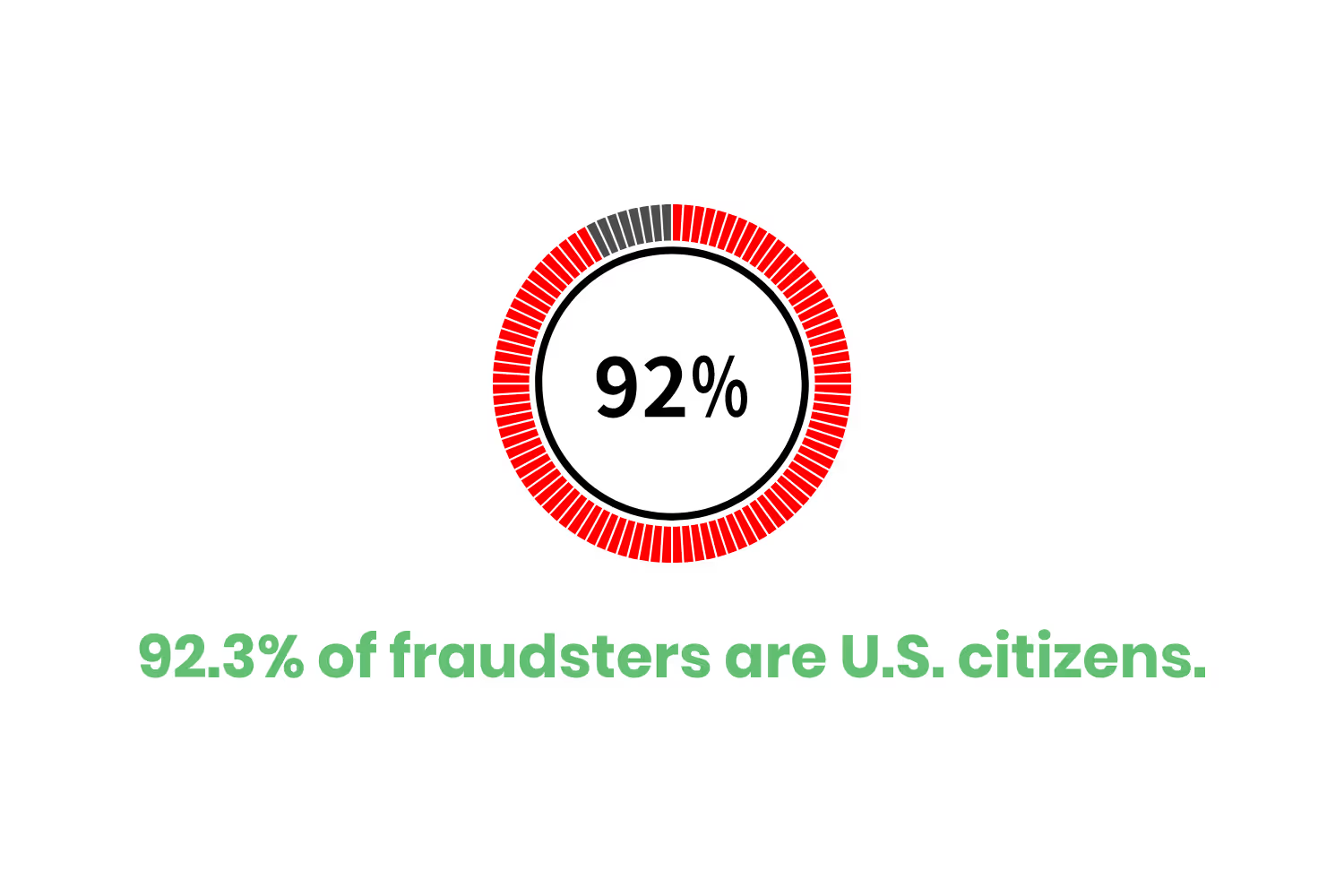
The United States Sentencing Commission used their data generated in 2021 about healthcare fraud offenders to provide the following statistics…
- 65.8% of healthcare fraud perpetrators are men.
- The average age of a healthcare fraud offender is 50.
- The demographic breakdown of healthcare fraud offenders is…
- 53.4% are White
- 18.8% are African American
- 18.5% are Hispanic
- 9.3% are “other” ethnicities
- 92.3% of fraudsters are U.S. citizens.
- 92% of healthcare fraudsters had no prior (or very little) criminal history.
Characteristics of Offenses
The same “Quick Facts: Healthcare Fraud Offenses” analysis conducted by the Sentencing Commission looked at commonalities and trends for the offenses committed by the fraudsters.
You see, some locations in the U.S. are more prone to fraud than others because people think they can get away with the crime. There are also some trends relating to the courts increasing or decreasing someone’s punishment for committing these fraud offenses.
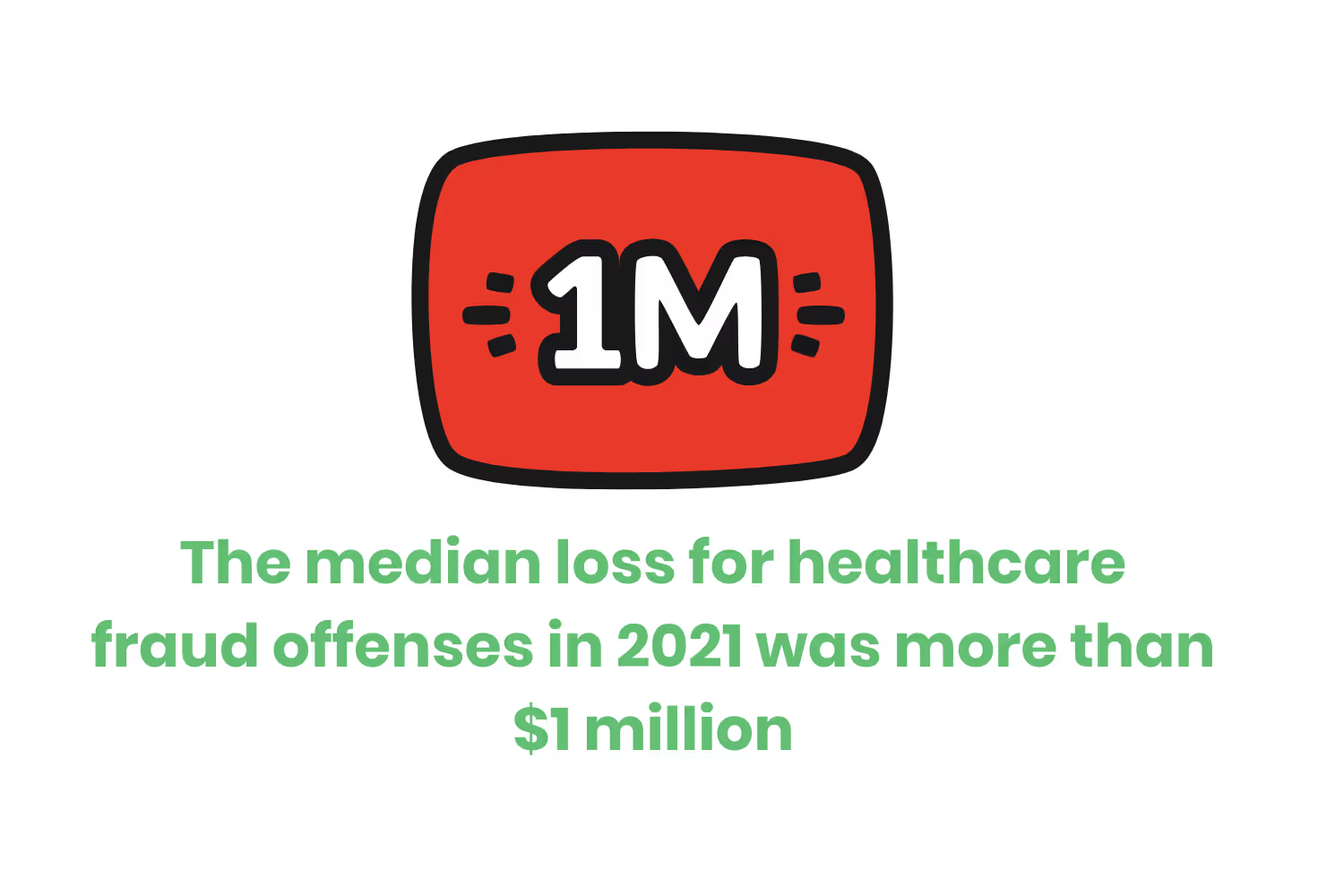
Below are the statistics from all of the crimes the caught fraudsters committed in 2021.
- The median loss for healthcare fraud offenses in 2021 was more than $1 million.
- 18.8% of cases involved monetary loss of $150,000 or less.
- 17.3% of cases involved monetary loss greater than $9.5 million.
- The top five districts for healthcare fraud and the number of offenders in 2021 were…
- 31 cases in the Northern District of Alabama
- 30 cases in the Southern District of Florida
- 22 cases in the Northern District of Texas
- 21 cases in the Southern District of Texas
- 17 cases in the Central District of California
- 21.7% of increased sentences relate to the number of victims or the extent of harm to victims
- 36% of increased sentences relate to the conviction of a federal health care offense involving a government health care program and a loss of more than $1 million.
- 16.7% of increased sentences relate to using sophisticated means to execute or conceal the offense.
- 9.2% of increased sentences relate to using an unauthorized means of identification.
- 26.8% of increased sentences relate to leadership or supervisory role in the offense.
- 30.7% of increased sentences relate to abusing a public position of trust or using a special skill.
- 5.1% of increased sentences relate to obstructing or impeding the administration of justice.
- The only time a healthcare fraudster had their sentence deceased was for minor or minimal participation in the offense.
- This happened in 5.4% of cases.
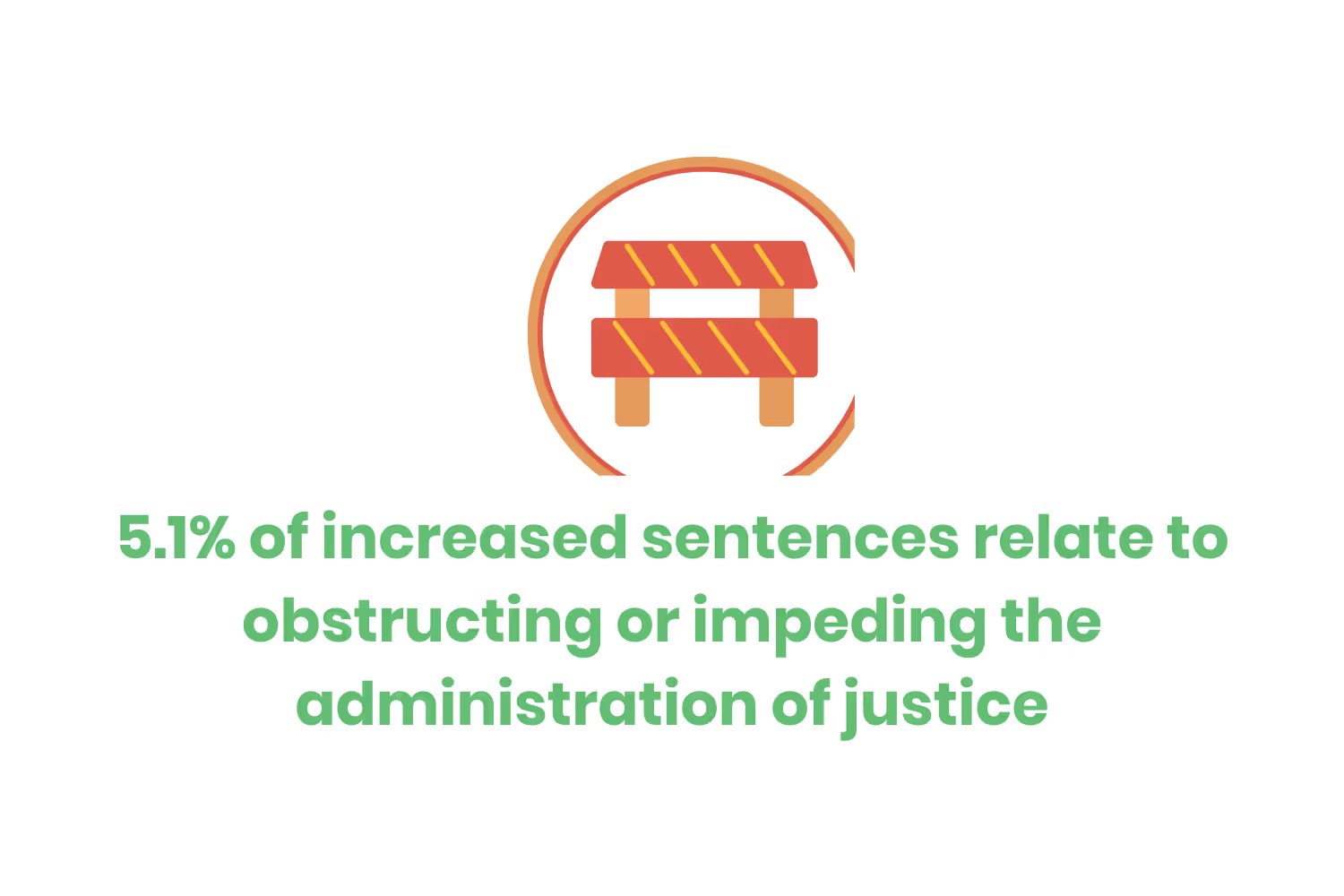
Healthcare Fraud Investigation Statistics
For every law in the United States, some organization investigates people suspected of breaking the law. When it comes to healthcare fraud, the federal government has a few agencies to help catch these criminals.
These agencies include…
- The Department of Justice (DOJ)
- The Federal Bureau of Investigations (FBI)
- The Department of Health and Human Services (HHS)
- The HHS’s Office of Inspector General (HHS-OIG)
All of these organizations conduct many investigations across the U.S. to catch healthcare fraud before it negatively affects patients’ lives. Below are some healthcare fraud statistics concerning investigations and their results.

- The federal government won/negotiated more than $5.0 billion in healthcare fraud judgments, settlements, and other healthcare administrative impositions in 2021. (HHS 2021 Annual Report)
- The DOJ opened 831 new criminal healthcare fraud investigations in 2021. (HHS 2021 Annual Report)
- In 2020, the DOJ opened 1,148 healthcare fraud investigations. (HHS 2020 Annual Report)
- Also in 2021, the DOJ opened 805 new civil healthcare fraud investigations. (HHS 2021 Annual Report)
- In 2020, the DOJ opened 1,79 new civil healthcare fraud investigations. (HHS 2020 Annual Report)
- The FBI opened 593 new healthcare fraud investigations in 2021. (HHS 2021 Annual Report)
- 2021 FBI investigations disrupted over 559 criminal fraud organizations. (HHS 2021 Annual Report)
- They subsequently dismantled the criminal hierarchy of 107 healthcare fraud criminal enterprises
Healthcare Fraud Convictions and Prosecutions
If the investigations conducted by the various organizations listed above prove that someone committed fraud, the fraudster faces arrest, prosecution, and often conviction. The majority of defendants accused of healthcare fraud face punishment and often go to prison for their actions.
Below are some statistics about healthcare fraud convictions and prosecutions. These statistics specify which organizations did what to prosecute and convict these people.

- At the end of 2021, the DOJ had 1,432 civil healthcare fraud matters pending. (HHS 2021 Annual Report)
- In 2020, the DOJ had 1,498 civil health care fraud matters pending. (HHS 2020 Annual Report)
- The 2021 Healthcare Fraud National Enforcement action changed more than 138 defendants. (DOJ Press Release)
- This involved more than 42 licensed medical professionals
- 2021 FBI investigations produced…. (HHS 2021 Annual Report)
- 470 criminal healthcare fraud convictions
- 526 indictments
- 281 prosecutors information
- Thanks to FBI investigations in 2021, federal prosecutors filed criminal charges in 462 cases involving 741 defendants. (HHS 2021 Annual Report)
- 312 defendants received a conviction of healthcare fraud-related crimes that year
- In 2020, the FBI investigations led to 412 cases involving 679 defendants. (HHS 2020 Annual Report)
- 440 of these defendants received convictions of healthcare fraud-related crimes that year.
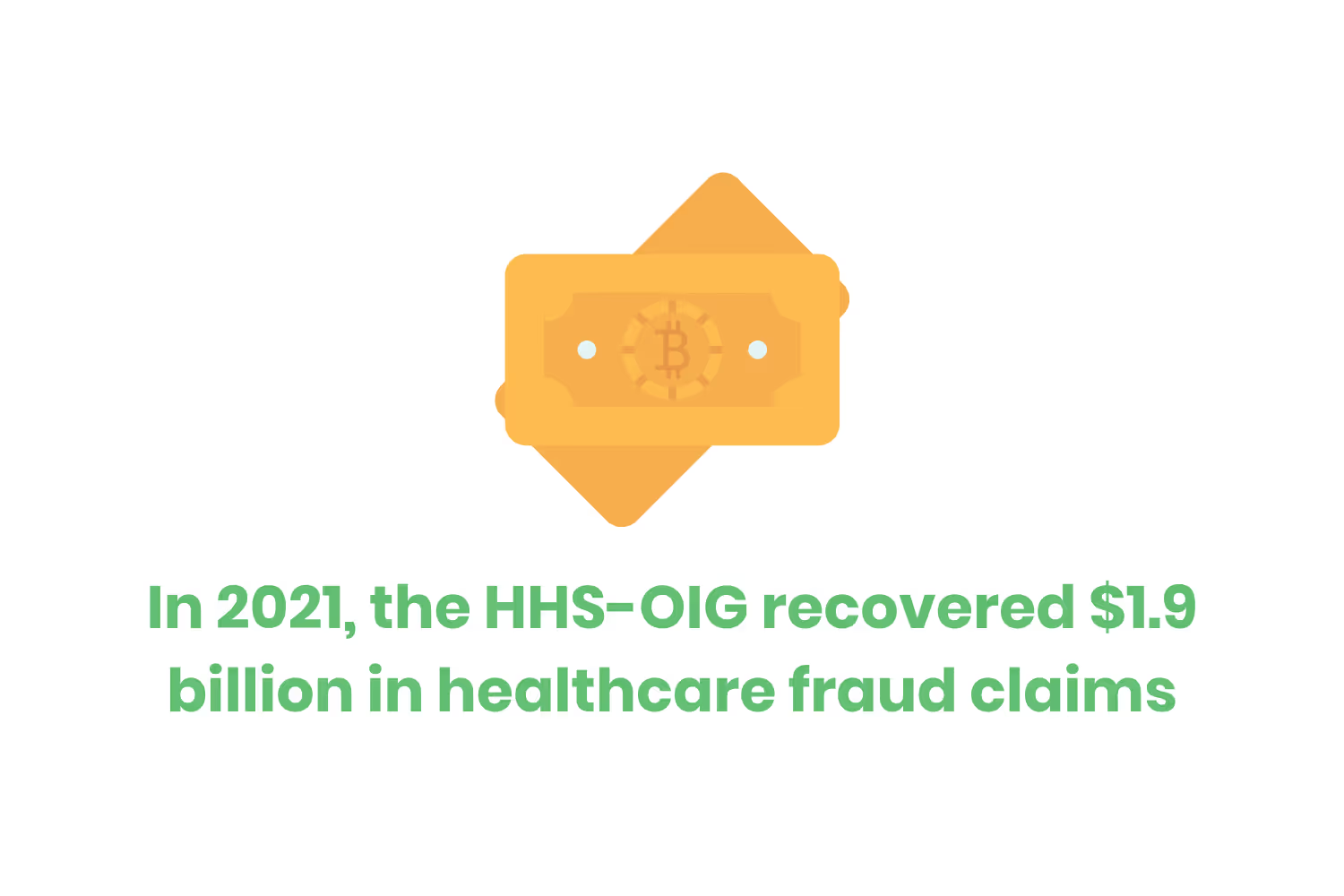
- Of the 52.4% of fraudsters sentenced under the Guidelines Manual… (U.S. Sentencing Commission)
- 34.1% of sentences happened within the guideline range.
- 58% of these offenders received a substantial assistance departure.
- 6.8% of these offenders received some other type of downward departure.
- HHS-IOG investigations resulted in 504 criminal actions against people/organizations engaging in medicare and Medicaid-related crimes in 2021. (HHS 2021 Annual Report)
- They also resulted in 669 civil actions, including…
- false claims
- unjust enrichment lawsuits
- civil monetary penalty settlements
- They also resulted in 669 civil actions, including…
- In comparison, HHS-IOG investigations resulted in 578 criminal actions related to Medicare and Medicaid and 781 civil actions in 2020. (HHS 2020 Annual Report)
- In 2021, the HHS-OIG recovered $1.9 billion in healthcare fraud claims. (HHS 2021 Annual Report)
- In 2020, they recovered $3.1 billion in false and fraudulent claims. (HHS 2020 Annual Report)
- 47.6% of healthcare fraud offenders received a variance. (U.S. Sentencing Commission)
- All of these people received a downward variance.
- The average sentence reduction was 56.6%
- In 2021, the FBI partnered with the DOC in a national Healthcare Fraud (HCF) Law Enforcement Action. (HHS 2021 Annual Report)
- This resulted in 117 people for their alleged participation in healthcare fraud schemes
- These people included 39 doctors, nurses, and other licensed medical professionals
- The fraud schemes involved false billing worth about $1.1 billion.
- This resulted in 117 people for their alleged participation in healthcare fraud schemes
Conclusion
Unfortunately, healthcare fraud happens all the time. Many patients don't realize that it’s happening because it usually doesn’t affect their wallets. Many fraudsters prefer to target pharmacies or insurance companies since it’s more lucrative.
This type of crime has serious costs associated with it. Not only is it expensive because of the money the fraudster steals, but also because of the jail times and penalties fraudsters face when caught.
As you can see from the healthcare fraud statistics above, the situation is grim. Healthcare entities must check their books and their prescription notes. All staff must be accountable for their actions to identify the fraud before it creates a serious negative impact.
Emphasize your product's unique features or benefits to differentiate it from competitors
In nec dictum adipiscing pharetra enim etiam scelerisque dolor purus ipsum egestas cursus vulputate arcu egestas ut eu sed mollis consectetur mattis pharetra curabitur et maecenas in mattis fames consectetur ipsum quis risus mauris aliquam ornare nisl purus at ipsum nulla accumsan consectetur vestibulum suspendisse aliquam condimentum scelerisque lacinia pellentesque vestibulum condimentum turpis ligula pharetra dictum sapien facilisis sapien at sagittis et cursus congue.
- Pharetra curabitur et maecenas in mattis fames consectetur ipsum quis risus.
- Justo urna nisi auctor consequat consectetur dolor lectus blandit.
- Eget egestas volutpat lacinia vestibulum vitae mattis hendrerit.
- Ornare elit odio tellus orci bibendum dictum id sem congue enim amet diam.
Incorporate statistics or specific numbers to highlight the effectiveness or popularity of your offering
Convallis pellentesque ullamcorper sapien sed tristique fermentum proin amet quam tincidunt feugiat vitae neque quisque odio ut pellentesque ac mauris eget lectus. Pretium arcu turpis lacus sapien sit at eu sapien duis magna nunc nibh nam non ut nibh ultrices ultrices elementum egestas enim nisl sed cursus pellentesque sit dignissim enim euismod sit et convallis sed pelis viverra quam at nisl sit pharetra enim nisl nec vestibulum posuere in volutpat sed blandit neque risus.

Use time-sensitive language to encourage immediate action, such as "Limited Time Offer
Feugiat vitae neque quisque odio ut pellentesque ac mauris eget lectus. Pretium arcu turpis lacus sapien sit at eu sapien duis magna nunc nibh nam non ut nibh ultrices ultrices elementum egestas enim nisl sed cursus pellentesque sit dignissim enim euismod sit et convallis sed pelis viverra quam at nisl sit pharetra enim nisl nec vestibulum posuere in volutpat sed blandit neque risus.
- Pharetra curabitur et maecenas in mattis fames consectetur ipsum quis risus.
- Justo urna nisi auctor consequat consectetur dolor lectus blandit.
- Eget egestas volutpat lacinia vestibulum vitae mattis hendrerit.
- Ornare elit odio tellus orci bibendum dictum id sem congue enim amet diam.
Address customer pain points directly by showing how your product solves their problems
Feugiat vitae neque quisque odio ut pellentesque ac mauris eget lectus. Pretium arcu turpis lacus sapien sit at eu sapien duis magna nunc nibh nam non ut nibh ultrices ultrices elementum egestas enim nisl sed cursus pellentesque sit dignissim enim euismod sit et convallis sed pelis viverra quam at nisl sit pharetra enim nisl nec vestibulum posuere in volutpat sed blandit neque risus.
Vel etiam vel amet aenean eget in habitasse nunc duis tellus sem turpis risus aliquam ac volutpat tellus eu faucibus ullamcorper.
Tailor titles to your ideal customer segment using phrases like "Designed for Busy Professionals
Sed pretium id nibh id sit felis vitae volutpat volutpat adipiscing at sodales neque lectus mi phasellus commodo at elit suspendisse ornare faucibus lectus purus viverra in nec aliquet commodo et sed sed nisi tempor mi pellentesque arcu viverra pretium duis enim vulputate dignissim etiam ultrices vitae neque urna proin nibh diam turpis augue lacus.




